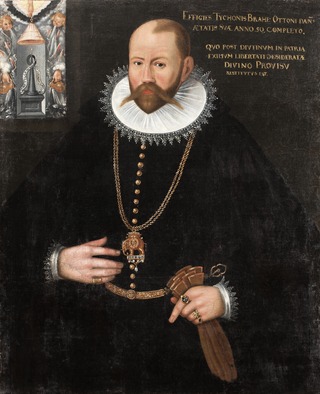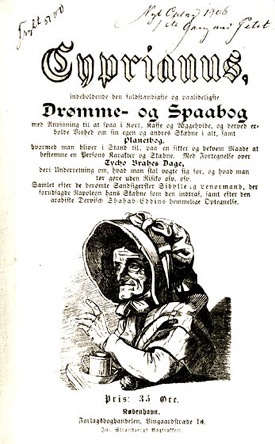
Tycho Brahe, generally called Tycho for short, was a Danish astronomer of the Renaissance, known for his comprehensive and unprecedentedly accurate astronomical observations. He was known during his lifetime as an astronomer, astrologer, and alchemist. He was the last major astronomer before the invention of the telescope. Tycho Brahe has also been described as the greatest pre-telescopic astronomer.

Uraniborg was an astronomical observatory and alchemy laboratory established and operated by the Danish astronomer Tycho Brahe. It was the first custom-built observatory in modern Europe, and the last to be built without a telescope as its primary instrument.

The Tychonic system is a model of the universe published by Tycho Brahe in 1588, which combines what he saw as the mathematical benefits of the Copernican system with the philosophical and "physical" benefits of the Ptolemaic system. The model may have been inspired by Valentin Naboth and Paul Wittich, a Silesian mathematician and astronomer. A similar cosmological model was independently proposed in the Hindu astronomical treatise Tantrasamgraha by Nilakantha Somayaji of the Kerala school of astronomy and mathematics.

John Louis Emil Dreyer, also Johan Ludvig Emil Dreyer, was a Danish astronomer who spent most of his career working in Ireland. He spent the last decade of his life in Oxford, England.

The Constantinople observatory of Taqi ad-Din, founded in Constantinople by Taqi ad-Din Muhammad ibn Ma'ruf in 1577, was one of the largest astronomical observatories in the pre-modern world. However, it only existed for a few years and was destroyed in 1580.

The Copernican Revolution was the paradigm shift from the Ptolemaic model of the heavens, which described the cosmos as having Earth stationary at the center of the universe, to the heliocentric model with the Sun at the center of the Solar System. This revolution consisted of two phases; the first being extremely mathematical in nature and the second phase starting in 1610 with the publication of a pamphlet by Galileo. Beginning with the 1543 publication of Nicolaus Copernicus’s De revolutionibus orbium coelestium, contributions to the “revolution” continued until finally ending with Isaac Newton’s work over a century later.

SophiaThott Lange, known by her maiden name, was a Danish noblewoman and horticulturalist with knowledge of astronomy, chemistry, and medicine. She worked alongside her brother Tycho Brahe in making astronomical observations.

Lars Lindberg Christensen is a science communicator and author of a dozen books on astronomy and science communication translated to ten languages.

Reinhard Genzel is a German astrophysicist, co-director of the Max Planck Institute for Extraterrestrial Physics, a professor at LMU and an emeritus professor at the University of California, Berkeley. He was awarded the 2020 Nobel Prize in Physics "for the discovery of a supermassive compact object at the centre of our galaxy", which he shared with Andrea Ghez and Roger Penrose. In a 2021 interview given to Federal University of Pará in Brazil, Genzel recalls his journey as a physicist; the influence of his father, Ludwig Genzel; his experiences working with Charles H. Townes; and more.

An astronomical catalog or catalogue is a list or tabulation of astronomical objects, typically grouped together because they share a common type, morphology, origin, means of detection, or method of discovery. The oldest and largest are star catalogues. Hundreds have been published, including general ones and special ones for such objects as infrared stars, variable stars, giant stars, multiple star systems, star clusters, and so forth.
Andrzej Jarosław Udalski is a Polish astronomer and astrophysicist, and director of the Astronomical Observatory of the University of Warsaw. He is also head of the Department of Observational Astrophysics at Astronomical Observatory, the head and project manager of the Optical Gravitational Lensing Experiment, and editor of the quarterly journal Acta Astronomica.

Françoise Combes is a French astrophysicist at the Paris Observatory and a professor at the Collège de France where she has been the chair of Galaxies and cosmology since 2014.
Raymond Neil Wilson was an English physicist and telescope optics designer, best known for pioneering the use of active optics in large telescopes.

Nonius is a measuring tool used in navigation and astronomy named in honour of its inventor, Pedro Nunes, a Portuguese author, mathematician and navigator. The nonius was created in 1542 as a system for taking finer measurements on circular instruments such as the astrolabe. The system was eventually adapted into the Vernier scale in 1631 by the French mathematician Pierre Vernier.

In the folklore of Scandinavia, Tycho Brahe days are days judged to be especially unlucky, especially for magical work, and important business transactions. Tycho Brahe (1546–1601) was a Danish astronomer, astrologer, and alchemist and as such achieved some acclaim in popular folklore as a sage and magician.
59 Virginis is a G-type main-sequence star, located in constellation Virgo at approximately 57 light-years from Earth.
Owen Hannaway was a Scottish historian of science. He was particularly known for work in the history of chemistry, especially the 1975 book The Chemists and the Word: The Didactic Origins of Chemistry. He was a professor and department chair at Johns Hopkins University.
Michael Perryman is a British astronomer, known for his work leading the Hipparcos and Gaia space astrometric projects.

Stefano Vitale is an Italian physicist and a retired professor of experimental physics at the University of Trento. He is known for his scientific contributions in the field of gravitational wave (GW) research and the successful management of international scientific projects.













